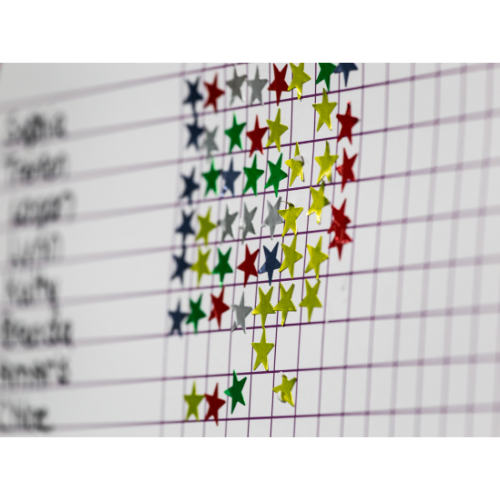Social stories are an intervention strategy that aims to make everyday situations or experiences explicit and understandable to people.
I use social stories ALL THE TIME with the students that I work with, and I have seen students’ behavior and understanding of situations improve while using social stories.
I can’t wait for you to learn more about this valuable resource!

What is a social story and how is it used?
Social stories are short stories that can be written by parents, educators, or professionals. Social stories are great way to teach your child or teen about a certain topic.
Many times, social stories can be helpful to people who have learning challenges, such as people with Attention Deficit Hyperactivity Disorder (ADHD), Autism, Intellectual Disability, or learning disabilities.
Carol Gray, one of the leading innovators of using and creating social stories, started using social stories to support children and teens approximately 25 years ago. Ms. Gray’s easy-to- use strategies make it simple for educators, parents, and providers to craft a social story to fit any need.
Which is the best definition for social stories?
According to Ms. Gray, social stories “accurately describe a context, skill, achievement, or concept according to 10 defining criteria. These criteria guide Story research, development, and implementation to ensure an overall patient and supportive quality, and a format, “voice” content, and learning experience that is descriptive, meaningful and physically, socially, and emotionally safe for the child, adolescent or adult with autism.”
What is an example of a social story?
Social story topics are endless. If your child or teens needs support learning about a new environment (like going to the dentist), or a new skill (like how to compliment others), or how to take care of personal needs (like getting dressed), a social story can be an incredibly helpful tool.
Ms. Gray outlines 10 important criteria to use when writing a social story in her book, The New Social Story Book.
Her 10 criteria to write a successful social story include:
- Creating a goal of why a person is writing a social story: It is important to share information that is accurate, descriptive, meaningful, and physically, socially and emotionally safe for the “Audience” (intended reader).
- Two- Step Discovery: The writer of the social story gathers information to help understand what the Audience needs to learn about, then uses that information gathered to plan for a specific topic or type of information for the social story.
- Three Parts and a Title: A quality social story will have at least three parts: an introduction, body, and conclusion, as well as a title.
- FOURmat Makes it Mine: make sure that the formatting of the story considers the Audience’s abilities, attention span, learning style, and interests or skills.
- Five Factors Define Voice and Vocabulary: the author will mindfully consider what perspective they write from (ex. 1st or 3rd person), use a patient and positive tone, use the correct tense for the context (past/ present/ or future), be accurate even when interpreted literally (which is important for a reader who may read and understand information literally), and is accurate in it’s meaning.
- Six questions guide story development: use “wh” (who; what; when; where; why) and “how” questions to guide the information presented in the social story and how the information is shared.
- Seven is about sentences: Consider if the author will use descriptive or coaching sentences when creating the stories.
- A GR-EIGHT formula: When writing a social story, the author will divide the number of descriptive sentences by the number of coaching sentences. Ms. Gray advises that a quality social story will the answer must be greater than or equal to 2.
- Nine Makes it Mine: The author makes sure that all criteria are followed to create a quality social story.
- Ten Guides to Implementation: When using the social story, the author will ensure that the Audience (reader) can comprehend the story. They will use the Social Story as a support for the Audience. The story will be presented to the audience in a positive and patient manner, and NEVER forced upon the audience. The audience may review the social story by themselves if that is preferable to them. The creator of the social story will monitor the use and see if revisions need to be made based on the response of the audience. The stories can be organized in multiple ways, such as in a 3 ring binder, stapled together, or saved on a computer drive. Ms. Gray advises that social stories can be “mixed and matched” as audiences’ may end up needing a different “angle” or focus based on current needs. Additionally, the audience may need a re-run or sequel to a previously shared social story based on current needs. Once the author has shared a social story and that area becomes mastered, the social story can be altered to reflect the mastery of that topic. We all need applause and praise, and this can be a great way to celebrate mastery of a topic! As needed, social stories can be updated and new stories can be introduced as needed.
What do I do next?
Once you have all of those criteria covered, you are ready to write your social story! I personally prefer writing social stories in Google slides. I create a Google folder for each student that I work with and save their personalized social story in their Google folder. This allows me to quickly and easily access each child’s materials. As a bonus, the teacher is also able to share the Google slide social story as a whole class lesson on the SmartBoard if the topic is applicable to all students (ex. explaining an upcoming fire drill for school).
Since I LOVE using social stories, I have included some FREE social story templates here! If you need help writing a social story, let me know, and I’m happy to give some ideas.
Full disclosure, some of my links may include Amazon links. I am an affiliate, and if you purchase an item through my link, I may earn a commission at no extra cost to you 🙂






